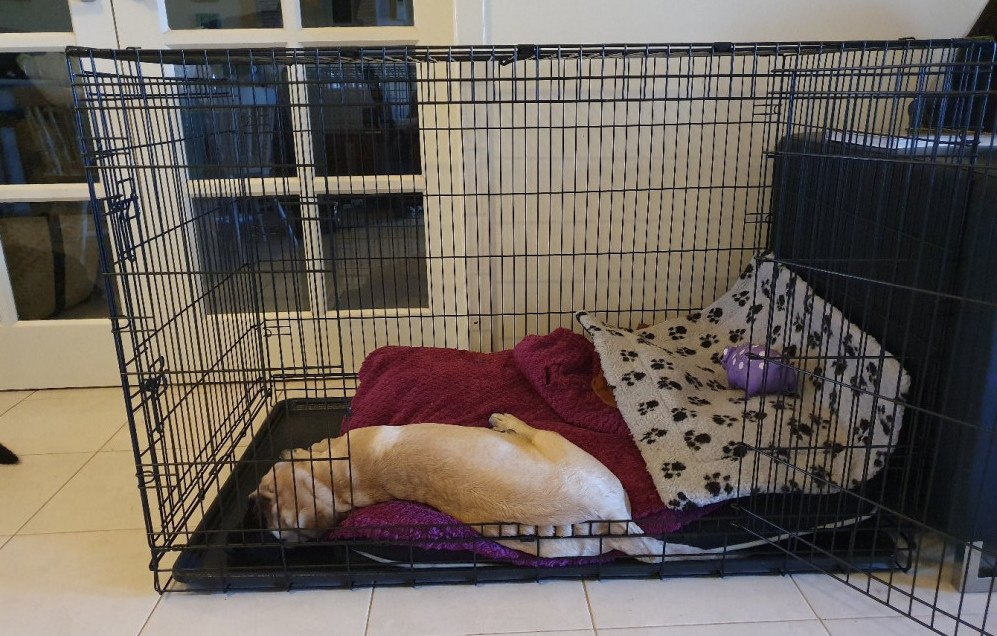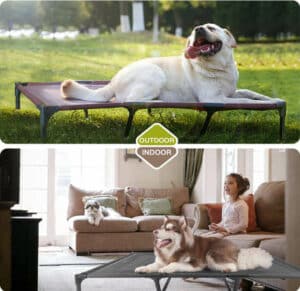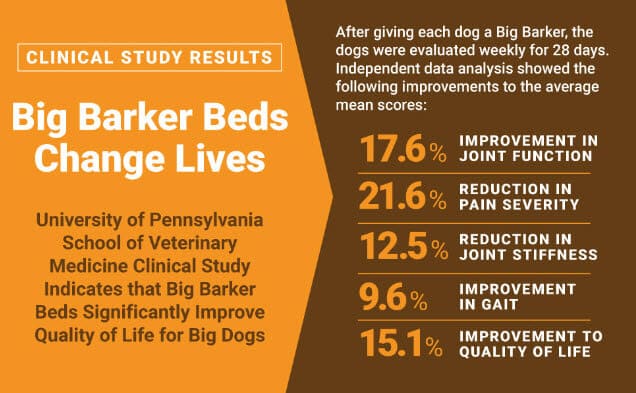Which dog bed is best for your pup? It’s a valid question, and there are many factors to consider when making your decision. In this blog post, we will answer 20 popular questions about dog beds.
From the type of bed to the material it’s made from, we will cover everything you need to know before purchasing a bed for your furry friend. So, whether you are looking for a orthopedic dog bed or simply want to know what is the best material for a bed, keep reading!
What Type Of Bed Is Best For Dogs?
Waterproof or water-resistant beds can be helpful in preventing accidents, as well as easy to clean.
Dog beds come in all shapes and sizes, so you’ll be able to find one that fits your dog’s needs.
If you have an older dog, consider a bed with sides or a bolster to help your pet feel secure.
For dogs who like to chew, choose a durable bed that can stand up to wear and tear.
Dog beds are available in a wide range of prices, so you can find one that fits your budget.
When choosing a bed for your dog, make sure to consider your pet’s sleeping habits and overall health.
A comfortable bed will provide your dog with a place to rest and relax, which can help promote good health and vitality.
related article in ourDogsWorld101.com
The picture here is of my Mastiff, and Co-Founder here at Our Dogs World 101. The article “Do I Need To Get My Dog A Dog Bed?” was inspired by her!

Do Dogs Prefer Round Or Square Beds?
Dogs that love to lay out flat should not be forced to curl up and nest. And dogs that love the security of nesting and cuddling up against a wall will prefer a square or rectangular bed.
Some dogs will have a preference for one shape over another, but ultimately it is up to the owner to decide which type of bed will be best for their dog. Dog beds come in all shapes and sizes, so there is sure to be one that is perfect for every pup.
Do Dogs Prefer Round Or Square Beds?
When it comes to choosing a bed for your dog, you may be wondering if it makes a difference whether you select a round or square option.
While there are benefits to both types of beds, ultimately it is up to you and your dog to decide which one will work best.

Here are some things to keep in mind when making your decision:
Benefits Of A Round Dog Bed
- They are typically less expensive than square beds.
- They take up less space in your home.
- They can be easily moved from one location to another.
Benefits Of A Square Dog Bed
- They provide more support for your dog’s body.
- They offer more coverage and security for dogs that like to nest.
- They can be placed against a wall or in a corner for added stability.
Ultimately, the decision of which type of bed to choose for your dog is up to you. Consider your dog’s needs and preferences when making your decision to ensure that they are as comfortable as possible.
Dog beds come in all shapes and sizes, so there is sure to be one that is perfect for every pup. When it comes to choosing a bed for your dog, keep in mind their needs and preferences to ensure that they are as comfortable as possible.
Is It Better For Dogs To Sleep On The Floor Or a Bed?
During the summertime, that comfy overstuffed bed might hold in excess heat, making it uncomfortable for your pup. A cool tile floor is refreshing, and can help keep your dog’s body temperature down.

You might also want to consider getting a cooling mat or Dog Bed for your pet to lie on during the summer months.
In the wintertime, a Dog Bed off the ground can offer warmth and insulation that a cold hard floor cannot.
If you have tile or hardwood floors, placing a rug under the Dog Bed can help add an extra layer of warmth.
There are pros and cons to both Dog Beds and sleeping on the floor, so ultimately it is up to you to decide what is best for your furry friend. Just remember to take into account the season and temperature when making your decision!
Do Dogs Really Need a Dog Bed?
As dogs age, they may develop problems like arthritis, hip dysplasia, and other age-related issues. Dog beds can provide much-needed support and comfort to our furry friends as they deal with these conditions.
Additionally, dog beds can help keep our dogs clean and dry by providing a place for them to rest that is off the ground and away from dirt and mud. Dog beds are also great for keeping our dogs warm in colder weather.
So, do dogs really need a dog bed? While they are not absolutely essential, dog beds can certainly make our dogs’ lives more comfortable, especially as they age.
If you are considering getting a dog bed for your furry friend, be sure to choose one that is the right size, offers the desired level of support, and is made from materials that will suit your dog’s needs.
How Do I Choose a Pet Bed?
Your dog’s bed should be large enough to allow them to sleep in any position without hitting the floor, and consider getting a Dog Ramp to help your pet get in and out of their bed.
Dog beds come in many shapes and sizes, so it’s important to measure your dog before choosing one. The most common types of dog beds are rectangular, square, or round.
If you have a small dog, you may want to consider getting a Dog Crate that doubles as their bed. This way, they will have their own space that they can retreat to when they need some alone time.

Dog crates come in all different sizes, so be sure to choose one that is big enough for your dog to stand up and turn around in.
No matter what type of dog bed you choose, be sure to pick one that is comfortable and will provide your dog with the support they need.
Dog beds are made from a variety of materials, including memory foam, orthopedic foam, and cotton.
Memory foam is a great choice for dogs with joint pain or other health issues, as it will contour to their body and provide support where they need it most.
Orthopedic foam is also a good choice for older dogs or those with health problems, as it is designed to reduce pressure points and provide overall body support.
Cotton dog beds are a good choice for all dogs, as they are comfortable and breathable. Be sure to choose a dog bed that is machine washable for easy care.
When choosing a pet bed, it’s important to consider your pet’s needs and preferences. Dog beds come in a variety of shapes, sizes, and materials, so be sure to choose one that is comfortable and supportive for your pet.
How Long Is a Dog Bed Good For?
A dog bed can be an expensive investment that, if maintained properly, can last for well up to five years and more.
It’s important to note, however, that not all dog beds are created equal. Some factors such as the size and weight of your dog, as well as how often the bed is used, can play a role in how long it will last.
When it comes to dog beds, there are a few things you’ll want to keep in mind in order to make sure you’re getting the most bang for your buck.
First, consider the size of your dog. If you have a small dog, you’ll want to make sure you get a bed that’s specifically designed for small dogs. The same goes for larger breeds – you don’t want to end up with a bed that’s too small and won’t be able to support your dog’s weight.
Second, take into account how often the bed will be used. If your dog sleeps in their bed every night, you’ll want to make sure you get a bed that’s durable and can withstand regular use. On the other hand, if your dog only uses their bed occasionally, you may be able to get away with a cheaper option.
Finally, think about the type of material you want your dog’s bed to be made out of. If you’re looking for something that’s easy to clean, you might want to consider a bed made out of synthetic materials.
However, if you’re looking for a bed that’s more comfortable for your dog, you might want to opt for one made out of natural fibers like wool or cotton.
No matter what type of dog bed you decide to go with, remember that it’s an important investment for your dog’s health and happiness. With a little bit of research, you can find the perfect bed that will last for years to come.
Can a Dog Bed Be Too Big?
It’s important to get the right sized bed as this can make a big difference in your dog’s comfort. If the bed is too big, your dog may not be able to get cozy and comfortable, which can lead to restless nights.
On the other hand, if the bed is too small, your dog may feel cramped and uncomfortable.
The best way to find the perfect size bed for your dog is to measure them while they are sleeping. This will give you a good idea of how much space they need so you can find a bed that fits them perfectly.
If you have any questions about finding the right sized Dog Bed for your Dog you can use the guide below, or please feel free to contact us and we would be happy to help!
| Dog Size/Weight | Dog Bed Size | Dog Breed |
|---|---|---|
| 1-10 lbs | Extra Small 24"L x 18"W | Papillion Chihuahua Maltese |
| 11-25 lbs | Small 30"L x 21"W | Dachshund Pug Shih Tzu |
| 26-40 lbs | Medium 36"L x 24"W | Beagle Cocker Spaniel Scottish Terrier |
| 41-70 lbs | Large 42"L x 28"W | Boxer Basset Hounds Bull Terrier |
| 71-90 lbs | Extra Large 48"L x 30"W | Labrador Golden Retriever German Shepard |
| 91-120++ lbs | XX Extra large 52"L x 32"W | Great Dane Saint Bernard English Mastiff |
How Do Dogs Know Dog Beds Are For Them?
Because your dog knows its own smell, he will come to identify with his sleep area by scent. Dog beds are usually filled with your dog’s favorite smell – his own! This makes him feel right at home and comfortable in his own bed. Even if you move your dog’s bed to a new location, he’ll still be able to find it because of the familiar scent.
Because dogs have a natural instinct to burrow and nest, they feel safe and secure when they’re in a small, enclosed space. Dog beds often mimic this sensation by providing a raised rim or bolster that your dog can rest his head on. This gives your dog a sense of security, similar to what he would experience in the wild.
Dogs also enjoy the warmth and softness of most dog beds. After a long day of playing and exploring, it’s nice for your dog to have a cozy spot to relax in.
Dog beds are usually made with soft, comfortable materials that your dog will love snuggling up in.
So, how do dogs know dog beds are for them? It’s simple – they just feel right! Dog beds provide everything your dog needs to feel safe, comfortable, and relaxed. And when your dog is happy, you’re happy too!
Is It OK To Move A Dog’s Bed Around?
Yes you can definitely move a dog’s bed around. In fact, it’s often recommended to do so in order to keep your pup from getting too comfortable in one spot. This way they won’t get too attached to any one particular place and will be more open to trying new things.
If you’re going to be moving the bed around frequently, it’s a good idea to get one that’s easily portable. That way, you won’t have to worry about it taking up too much space or being too heavy to carry.
There are plenty of great options out there, so take your time and find one that’s right for you and your dog.
How Often Should I Replace My Dog’s Bed?
Dog beds should be replaced every 1 to 5 years depending on the wear and tear. Dog beds can last longer if they’re only used occasionally or by smaller dogs. But, if your dog sleeps on their bed every night and it starts to show wear and tear, it’s time for a new one.
You should also replace your dog’s bed if it becomes stained or smells bad. Dog beds can be expensive, so it’s important to choose one that will last.
When you’re looking for a new dog bed, keep in mind the following:
- The Size Of Your Dog: You’ll need to measure your dog before you shop for a new bed. Make sure to measure from the nose to the base of the tail and from the shoulder to the paw. This will help you find a bed that’s the right size for your dog.
- The Type Of Bed: Dog beds come in all shapes and sizes. You can choose from a traditional mattress style bed, a pillow bed, a orthopedic bed, or a heated bed. Consider your dog’s needs when choosing a bed. For example, older dogs may need an orthopedic bed to help relieve joint pain.
- The Material: Dog beds are typically made from cloth, foam, or fiberfill. Some beds have removable covers that can be washed. Others are made from waterproof or water-resistant materials. Consider what would work best for your dog and your home.
- The Price: Dog beds range in price from $25 to $700, and sometimes more.
Keep in mind that you’ll probably need to replace your dog’s bed more often than you would your own. Choose a bed that’s within your budget and will last as long as possible.
Where Do You Put a Dog Bed?
A corner, or at least against a wall, is usually the best location. Dogs like to feel safe and closed-in when settling down to sleep, so a bed placed in an open area of your home is likely to be less appealing. If you have limited space, try looking for beds that are elevated or designed to fit into small areas.
Another thing to consider is whether your dog likes to sleep in his crate. If so, you might want to put the bed inside the crate so he has a comfortable place to rest. Some dogs also prefer to sleep on a hard surface, so placing the bed on a mat or rug may not be ideal.
Ultimately, it’s up to you to experiment with different locations and see what works best for your pup.
Are Raised Beds Better For Dogs?
There is no definitive answer to this question, as there are pros and cons to both raised beds and traditional beds for dogs.
suddus elevated dog bed
- [Joint Protection] SUDDUS raised dog bed can prevent your dog from arthritis pain. Arthritis is more common in dogs than humans (especially large dogs and old dogs). If dogs always lie on the ground directly, they will suffer from dampness and arthritis will get worse. To protect your lovely dogs health, choose SUDDUS elevated dog bed!
- [Suitable For Four Seasons] In cold weather, this dog bed can avoid dog’s body contacting with coldness of the floor or moisture of the carpet. When it comes to hot weather, the ground temperature may go above 40℃, and dogs can get sunstroke lying on the ground. The elevated design also avoids the bites from bugs when dogs rest on the lawn.
- [Durable Bed Cover] Textilene dog bed cover is supportive, non-toxic, resistant to wear and tear, etc. Hot pressed one-piece PVC bed cover without line seam is extremely chew-proof and sturdy, which can avoid ripped seam situations.
- [Easy to Assemble and Clean] SUDDUS elevated dog bed is easy to assemble. We have a tutorial video and instructions for our customers. This elevated dog cot is removable and washable! When the doggy bed is dirty, you just need to wipe with a wet rag or rinse the doggy bed and it will air dry quickly.


Some people feel that raised beds are better for dogs because they offer more support and stability, which can be helpful for older or arthritic dogs. Raised beds can also keep your dog warmer in cooler weather, as they are off the ground and therefore not affected by cold floors.
On the other hand, some people prefer traditional beds for their dogs because they are lower to the ground and easier for your dog to get in and out of.
Ultimately, it is up to you to decide what type of bed is best for your dog based on their needs and preferences.
When Should I Throw Away My Dog’s Bed?
There are a few key indicators that it may be time to say goodbye to your dog’s bed. If the bed is starting to show signs of wear and tear, or if your dog is no longer using it as much as they used to, it may be time for a new one.
Additionally, if you notice any changes in your dog’s sleeping habits or health, it may be worth considering getting a new bed.
Ultimately, you know your dog best and will be able to tell when it is time for a change.
Is Memory Foam Good For Dog Beds?
A memory foam dog bed can help improve a dog’s overall health and mobility by eliminating pressure on certain points of the body and providing support where it’s needed most. Additionally, memory foam is hypoallergenic and resistant to dust mites, making it a good choice for dogs with allergies.
When shopping for a memory foam dog bed, look for one that offers the right level of firmness and support for your dog’s needs.
Dog beds made with lower-density memory foam may not provide enough support, while those made with higher-density memory foam may be too firm. For older dogs or those with joint pain, a medium-density memory foam bed may be the best option.
In addition to finding the right density of memory foam, make sure the bed you select is big enough for your dog to stretch out in comfortably. Dog beds come in a variety of sizes, so there’s sure to be one that’s perfect for your pet.
Memory foam dog beds can offer many benefits for dogs of all ages and sizes. With so many options available, it’s easy to find the perfect bed for your furry friend.
My first choice in memory foam dog beds is the Big Barker range. Big Barker make orthopedic beds for all sorts of animals, and their Dog Bed is one of the most comfortable and supportive memory foam beds on the market.
The Dog Bed from Big Barker is made with a high-density memory foam that provides excellent support for dogs weighing up to 150 pounds and more. The bed also has a waterproof liner and removable cover for easy cleaning.
related article in ourDogsWorld101.com
If you are considering a Big Barker dog bed, you should read our in depth review here before purchasing.

For smaller dogs, I like the Dog Bed from Big Barker. This bed is made with a medium-density memory foam that’s perfect for dogs up to 25 pounds. The bed also has a waterproof liner and machine-washable cover.
Whether you have a big dog or a small dog, there’s a memory foam dog bed out there that’s perfect for your pet. With so many benefits, it’s easy to see why memory foam dog beds are a popular choice for dog owners.
Should You Have a Dog Bed And a Crate?
While some dogs like to sleep on the floor, most prefer to be comfortable, safe, and warm by snuggling up in a dog bed.
Dog beds come in all shapes and sizes, from small mats to large, fluffy pillows, and can be made from a variety of materials, including memory foam, cotton, and even recycled materials.
Dog beds can also be crate-compatible, meaning they fit snugly inside your dog’s crate to provide extra warmth and comfort.
So, should you get a dog bed and a crate? The answer depends on your individual dog and their needs. If your dog sleeps comfortably on the floor or doesn’t seem to mind sleeping in their crate, then a dog bed may not be necessary.
However, if your dog prefers to sleep in a bed or is uncomfortable sleeping on the hard floor, then a dog bed may be a good option. Dog beds can also be helpful for elderly or disabled dogs who need extra support and comfort.
Ultimately, the decision of whether to get a dog bed and crate is up to you and your dog’s needs.
If you are thinking of crating your dog or puppy, please check out a recent article we wrote, “Until What Age Should A Dog Sleep In A Crate” where we cover the most common misconceptions and frequently asked questions in detail.
How Can I Make My Dog Bed More Comfortable?
Dog beds come in all shapes and sizes, but finding one that is comfortable for your dog can be tricky. If you’re looking for ways to make your dog’s bed more comfortable, here are a few tips.
- First, consider the size of the bed. Make sure it is big enough for your dog to stretch out in, but not so large that they feel lost in it.
- Second, think about the material the bed is made from. Dog beds can be made from a variety of materials, including memory foam, orthopedic foam, and even recycled denim. Choose a material that will be comfortable for your dog and easy to clean.
- Third, choose a bed with a removable cover. This way, you can easily wash the bedding when it gets dirty.
Finally, consider adding a few Dog Bed Dog toys or blankets to the bed to make it extra cozy. Your dog will love snuggling up in their new, comfortable bed!
How Thick Should a Dog Bed Be?
Look for a bed that is at least 4 inches in thickness at a bare minimum. This will ensure that your dog has plenty of support for their joints and bones, especially if they are older or suffer from arthritis or other joint conditions.
If you can find a bed that is 6 inches or thicker, that would be ideal. Dog beds that are too thin often do not provide enough support and can actually end up causing more pain for your dog instead of alleviating it.
When it comes to finding the perfect thickness for your dog’s bed, there are a few things to keep in mind. First, think about your dog’s weight and size. A larger Dog Bed will need to be thicker than a smaller Dog Bed.
Secondly, consider your dog’s age and health condition. Older dogs or those with joint problems will need a thicker bed for more support.
While there is no exact science to finding the perfect thickness for your dog’s bed, following these guidelines should help you find a bed that will provide your dog with the comfort and support they need.
What Kind Of Foam Is Best For Dog Beds?
There are a few things to consider when choosing the right type of foam for your dog’s bed, including durability, comfort, and support.
The most common types of foam used in dog beds are memory foam and orthopedic foam. Memory foam contours to your dog’s body and provides support for their joints and muscles. Orthopedic foam is firm and helps to distribute your dog’s weight evenly. It is also great for dogs with arthritis or other joint problems.
If you are looking for a durable option, polyurethane foam is a good choice. This type of foam is often used in furniture and is very strong and resistant to tearing. However, it can be less comfortable than memory or orthopedic foam.
When it comes to comfort, memory foam is the clear winner. This type of foam contours to your dog’s body and provides support for their joints and muscles. It is also very plush and soft, making it perfect for snuggling. However, memory foam can be more expensive than other types of foam.
If you are looking for a bed that provides both comfort and support, orthopedic foam is a great option. This type of foam is firm and helps to distribute your dog’s weight evenly. It is also great for dogs with arthritis or other joint problems. However, orthopedic foam can be less comfortable than memory foam.
No matter what type of foam you choose, make sure it is covered with a durable, washable cover. This will help extend the life of your dog’s bed and keep it looking its best.
How Many Dog Beds Should a Dog Have?
One, two, three… how many dog beds does a pup need?
We all want what’s best for our dogs, and that includes making sure they’re comfortable. After all, a happy dog is a good dog! So it’s no surprise that one of the most common questions we get asked here at Our Dogs World 101 is “How many dog beds should my pup have?”
The answer to this question depends on a few factors, including your dog’s age, size, and activity level. For example, a puppy who is still growing will need more than one bed so that he doesn’t outgrow his sleeping space too quickly.
On the other hand, an adult dog who sleeps a lot may be just fine with one bed.
Here are a few general guidelines to help you decide how many dog beds your pup needs:
Puppies:
It’s best to get two or more beds for puppies. They’re growing quickly, so they’ll need a new bed every few months. Puppies also like to chew, so getting them their own bed will save your furniture from being used as a chew toy!
Adult Dogs:
Most adult dogs only need one bed, but if they’re particularly active or sleep a lot, they may appreciate having two beds – one for inside and one for outside.
Seniors:
Older dogs may need more than one bed as well. They might sleep more than usual, and they may also have arthritis or other health conditions that make it difficult for them to get up and down. Having multiple beds will help make sure your senior dog is always comfortable.
No matter how many beds you get for your pup, the most important thing is that they’re comfortable and happy!
So take some time to figure out what type of bed(s) would work best for your dog and their needs. And if you have any questions, our experts are always here to help.
Do Dogs Prefer Hard Or Soft Beds?
Dogs don’t need soft beds, but instead need to rest on a firm surface; too-soft pillow beds can actually worsen joint pain.
Dog beds are available in a wide variety of materials, colors, and sizes. But when it comes to comfort, there’s really only two types of dog beds: hard and soft. So, which is best for your pup?
Hard Dog Beds
Hard dog beds are typically made out of plastic, metal, or wood. They provide a firm surface for your dog to sleep on and can be easily cleaned. Hard dog beds are also great for dogs who suffer from hip dysplasia or other joint problems since they won’t sink into the bed and put additional strain on their joints.
Soft Dog Beds
Soft dog beds are usually filled with some type of cushioning material, like memory foam, cotton, or polyester. They’re often covered in a soft fabric, like fleece or microsuede. Soft dog beds are ideal for dogs who like to snuggle up against something when they sleep. They’re also good for older dogs who may have joint pain since the soft cushioning will help to relieve some of the pressure on their joints.
So, which type of bed is best for your dog? If you’re not sure, it might be a good idea to get one of each and see which your dog prefers. Or, you can ask us here for our recommendation. We know a thing or two about dogs and beds!
The Verdict
So, what’s the verdict? What’s the best dog bed for your furry friend?
Well, it depends on their size and sleeping habits. If you have a small dog who likes to curl up in a ball or a medium-sized dog who stretches out when they sleep, either a bolster or rectangular bed would be good options.
If your pup likes to sprawl out, consider getting them a big dog bed. And finally, make sure to choose a bed that is easy to clean – whether that means machine-washable materials or removable covers.
With all of these factors in mind, we believe you can find the perfect bed for your pooch and give them the gift of sweet dreams!
Remember… Owning a dog should be FUN, not a chore!
My name is Mark and I currently live in Australia.
I am passionate about educating Doggie parents and helping you to make the best possible decisions to help your dog live a long, happy and healthy life.
As a Dog trainer & behaviorist I have always used The Dog Solution methods with a 100% success rate.
Feel free to contact us, and stay tuned for updates and informative posts on dog care, training, diet, and much more!
“Dogs do speak, but only to those who know how to listen” – Orhan Pamuk


